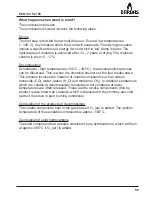
59
ECO 40 / 52 / 55
What happens when wood is burnt?
The combustion process.
The combustion of wood involves the following steps.
Drying
The fi rst step is that the fuel (wood) dries out. Even at low temperatures
(~ 100°C), any moisture still in the wood will evaporate. This drying procedure
implies a signifi cant loss of energy if wood which is ‘too’ damp is burnt. The
right degree of moisture is achieved after 1.5 - 2 years of drying. The moisture
content is then 15 - 17%.
Decomposition
At moderate - high temperatures (150°C - 350°C), the decomposition process
can be discerned. This is when the chemical structure of the fuel breaks down.
This process involves the creation of volatile compounds such as carbon
monoxide (CO), water vapour (H
2
O) and methane (CH
4
). In addition, substances
which are volatile at decomposition temperature but condense at lower
temperatures are often released. These are the tar-like components (this by-
product is also known as creosote, which is deposited in the chimney and cold
parts of the stove in poor burning conditions).
Combustion of the products of decomposition
The volatile compounds burn in the gas phase if O
2
(air) is added. The ignition
temperature of these volatile compounds is approx. 550°C.
Combustion of solid hydrocarbons
The solid component that remains consists of pure hydrocarbons, which will burn
at approx. 800°C if O
2
(air) is added.
Содержание ECO 52
Страница 2: ......
Страница 4: ...4 ECO 40 52 55 ECO 55 Steel ECO 55 Soapstone...
Страница 6: ...6 ECO 40 52 55...
Страница 48: ...48 ECO 40 52 55 12 DIMENSIONS 12 1 ECO 40 STEEL...
Страница 49: ...49 ECO 40 52 55 12 2 ECO 40 SOAPSTONE...
Страница 50: ...50 ECO 40 52 55 12 3 ECO 52 STEEL...
Страница 51: ...51 ECO 40 52 55 12 4 ECO 52 SOAPSTONE...
Страница 52: ...52 ECO 40 52 55 12 5 ECO 55 STEEL...
Страница 53: ...53 ECO 40 52 55 12 6 ECO 55 SOAPSTONE...


































